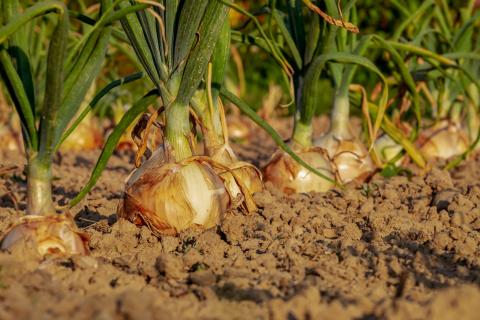How do I get my onions to grow bigger?

Onions are often billed as one of the easiest crops to grow. They don’t have many major pest issues and can be grown anywhere in the garden where the soil is well-drained and there is full sun exposure. Despite these advantages, gardeners are often dismayed when their onions fail to form large bulbs by the end of the season. If your onions didn’t size up as much as you’d like this season, consider the following tips for next year:
Choose the Right Variety
Onion varieties can be divided into three distinct categories: long-day, short-day and intermediate-day type onions. Onion plants rely on daylength to determine when they will start to form bulbs. Long-day onions start forming bulbs when they receive at least 14 hours of sunlight each day. These varieties are best for New Hampshire gardens, where summer days are long, and onions will have plenty of time to grow multiple leaves before bulb formation starts.
Short-day onions are a good choice for the deep south because they only need 10-12 hours of light to initiate bulb formation. Though you can grow short-day onions in the Granite State, they’ll likely only produce small bulbs, because they will put on bulb growth when they are still small and only have a few leaves. Intermediate-day varieties start growing bulbs when daylength reaches 12-14 hours. These are also unlikely to form full size bulbs in northern gardens.
Make sure you’re growing bulbing, not bunching onions. Bunching onions will grow into scallions, and they will never form large bulbs. Shallots will also stay much smaller than yellow, red or sweet onions.
Plant on Time
Planting onions too late usually results in disappointingly small bulbs. If you intend to grow onions from seed, you might want to start them indoors in the late winter/early spring to give them a jump start. Start onion seeds 10-15 weeks before you anticipate being able to transplant them into the garden, between mid-February and mid-March. Onions will tolerate light frost and can be planted in the garden in late April or May. It is also possible to directly sow seeds in the garden as soon as soil can be worked in the spring, but the resulting onions will likely be smaller.
Onion sets can also be planted as soon as the soil can be worked. Sets are small, juvenile bulbs that have been stored over the winter. Sets provide for an earlier harvest but won’t necessarily result in larger onions, just onions that mature faster. They are a dependable way to ensure a harvest. The only risk is that they might bolt (flower prematurely) if they are exposed to cold temperatures in the spring. Larger sets usually aren’t better than smaller ones because they are more likely to form flowers. Onions that flower develop mushy bulbs that are no longer edible, so if you see a flower head forming, harvest and eat that onion as soon as possible.
Thin Plants
When onions have to compete for sunlight, water and nutrients, they will often fail to produce many leaves as they need to grow large bulbs. Each onion leaf equates to a ring on a bulb, so a greater number of large, healthy leaves means bigger onions. If onions are planted too close to one another they will compete with one another, resulting in smaller bulbs. Whether direct seeding, transplanting seedlings or planting onion sets, onions should be spaced 3-4 inches apart to maximize growth.
Control Weeds
Onions tend to have very shallow root systems, which makes them poor competitors against neighboring weeds. Aim to keep the soil around onions weed-free by mulching with a thick layer of grass clippings, shredded leaves or clean straw. Frequent shallow cultivation between onion rows can also be effective. Simple hand tools are often all that is needed,just be careful to avoid disturbing onion plants. Shallow root systems mean they will come dislodged from the soil with little provocation, especially when they are young.
Water and Fertilize
Shallow roots also mean onions will dry out faster than other crops. They need frequent irrigation throughout the growing season in order to grow optimally. The rate of photosynthesis and growth slows down as soon as plants are moisture stressed, thus the upper few inches of soil should be kept moist but not soggy. It may be necessary to water once or twice a week depending on the weather. Stop watering once the tops begin to yellow and fall over to encourage the bulbs to finish maturing and to avoid rot issues.
Onions tend to grow very well in rich, organic soils with a pH at 6.5-6.8.Lean, acid soils can limit growth. Get your soil tested to make sure the pH is appropriate and key nutrients are available. Onions do benefit from proper fertilization (ideally based on soil test results), though high nitrogen fertilizers should be used with caution. Excessive nitrogen can delay bulb formation, maturity and the storability of onions.
Growing large onions is quite possible in New Hampshire gardens as long as you are thoughtful about how and when you plant and how you care for them during the growing season. You may find that a few simple changes are all that are needed for great success.
Got questions? The Ask UNH Extension Infoline offers practical help finding answers for your home, yard, and garden questions. Call toll free at 1-877-398-4769, Monday to Friday, 9 a.m. to 2 p.m., or e-mail us at answers@unh.edu.
Related Resource(s)
Do you love learning about stuff like this?
SUBSCRIBE TO Granite State Gardening newsletter
Got questions? The UNH Extension Yard and Garden Infoline offers practical help finding answers for your yard and garden questions.
Call toll free at 1-877-398-4769, Monday to Friday, 9 a.m. to 2 p.m., or fill out webform.
